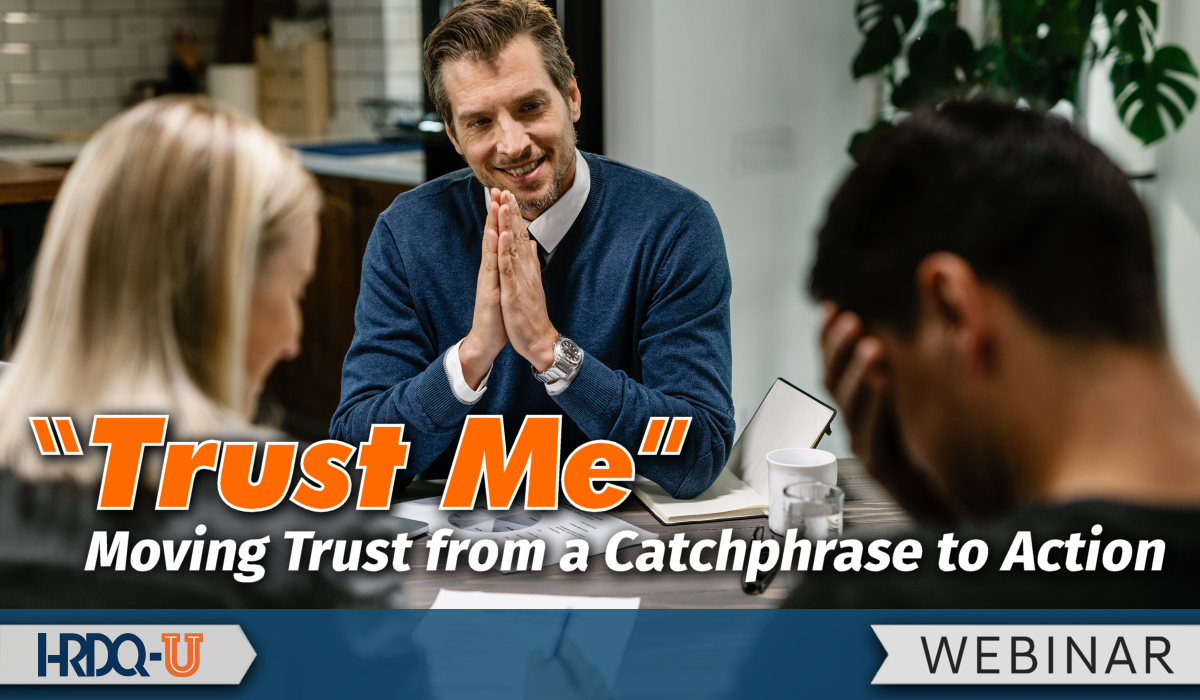- 827 Lincoln Ave. #B-10 West Chester, PA 19380
- support@hrdq.com
- +1-610-279-2002
Quick Links
Menu
Featured Topics
Menu
Total Results
We could not find what you're looking for. Please try again.No Record Found

As leaders, our ability to connect with our supervisor, direct reports, or colleagues makes a tremendous difference to our personal and professional success. The emotional currency that builds these connections is trust. In today’s business world, trust is a critical component of success. As a leader, it is crucial to grasp the significance of trust and learn how to build trust at work and uphold it.
Trust is what allows people to work together effectively. Trust is the bond that holds a team together when the stress mounts, the deadlines loom, and the disruptions continue. Out of trust grows camaraderie, creativity, and employee engagement. When we have a high level of trust with those we work with, and when our clients have a high level of trust with us, long-term benefits and gains are the result.
As a leader, fostering an environment of trust within your organization involves being transparent, honest, and reliable in all your interactions with others. It means following up when you say you will. It means caring about your colleagues – people want to know they are seen, heard, and valued. Trust builds strong relationships with your employees and customers and prioritizes ethical behavior in all business dealings.
What happens when trust is low or absent? Employees may be hesitant to share ideas or collaborate with others. Low morale can settle into teams, gossiping increases, and employees start to disengage. Unless addressed, this can lead to a lack of productivity, creativity, and innovation within the organization.
Furthermore, trust is crucial for building strong relationships with employees, customers, and partners. When people trust your organization, they are more likely to do business with you, recommend you to others, and remain loyal over time. Trust can also help build a positive reputation, making it easier to attract new customers and business partners.
This webinar will discuss the importance of trust in organizations, the benefits of building a culture of trust, and strategies for building and maintaining trust with employees, customers, and partners. By the end of this webinar, you will clearly understand how to build and maintain trust within your organization and why it is essential for long-term success.


Dare to Lead™ Course Discount
Webinar attendees qualify for a discount of 25% off a Dare to Lead™ course.
Based on the research of Dr. Brené Brown, Dare to Lead™ is an empirically based courage-building program. Brené calls this a “skill-based playbook for leaders.” The most significant finding from her latest research is that courage is a collection of four skill sets that are teachable, measurable, and observable.
Use code HRDQ-UDARETOLEADCOURSE to claim your discount.
Sarah Ciavarri, M.Div., PCC, CDTLF, Founder of Level Up Leadership, LLC, loves seeing leaders get excited about their lives and futures. As a certified Dare to Lead™ Facilitator, trained in all of Dr. Brené Brown’s research, and a Professional Certified Coach through the International Coaching Federation, Sarah is always seeking new adventures in helping leaders craft a life they love. For ten years, Sarah has traveled nationally, keynoting and facilitating workshops on resilience, vulnerability, and authenticity, and is a Chief Core Guide, DiSC, Motivator, and EQ trainer. Sarah is the author of Find Our Way to Truth: Seven Lies Leaders Believe and How to Let Them Go. And she got her afrave (afraid and brave at the exact same time) on this summer when she sang the National Anthem at a nationally televised Twins game!
Connect with Sarah at sarahciavarri.com.
Level Up Leadership, LLC is dedicated to supporting leaders to excel professionally and craft a life they love. As a certified Dare to Lead™ Facilitator, trained in all of Dr. Brené Brown’s research, and an Executive Leadership Coach, founder Sarah Ciavarri brings tremendous tools to help teams, groups, and individuals get unstuck with increased clarity and focus.
Learn more about Level Up Leadership, LLC at sarahciavarri.com
Training Tools for Developing Great People Skills
This event is sponsored by HRDQ. For 45 years HRDQ has provided research-based, off-the-shelf soft-skills training resources for classroom, virtual, and online training. From assessments and workshops to experiential hands-on games, HRDQ helps organizations improve performance, increase job satisfaction, and more.
Learn more at HRDQstore.com
“I was able to take away options on how to work with people on building trust within our company.”
– Theresa R.
“Good information and I learned a lot about trust in the workplace!”
– Antionette A.
“Today’s webinar on trust was a timely topic. I appreciate the presenter’s life examples and upbeat positive presentation.”
– Lynn W.

Sign up to be notified of upcoming live webinars, in-depth workshops, podcasts, blog posts, promotions and much more. Stay ahead of the curve and subscribe for FREE today!